Peatlands: A central challenge. Climate change is a defining dilemma of our times. Storing 30 to 40 percent of global soil carbon deposits on only 3 percent of the world’s land surface, tropical peatland ecosystems are a key component for mitigating climate change, and their preservation is crucial. Yet, tropical peatlands are diminishing every day under the combined pressures of an advancing agricultural frontier (oil palm, rubber and pulp plantations, and aquaculture); extractive economic activities (gas, petrol and logging); climate change (more hurricanes and droughts, and evapotranspiration); growing human populations; infrastructure development; and pollution. The draining, clearing and burning of peatlands not only produces deadly toxic haze, but also endangers the multitude of critical ecological services these landscapes provide. It also has direct and dire consequences for human livelihoods, health and wealth. There is an urgent need for coordinated, interdisciplinary, science-based national and international political responses that juggle the development and climate objectives of tropical countries.
Tropical peatlands are found in more than 80 countries, yet they remain among the least understood and monitored of the world’s ecosystems. Conducting new integrated research and development is paramount to informing proper prioritization between countries’ sometimes competing climate and development goals, and finding ways for peatland conservation, management and restoration to serve as a plausible aid to both. Peatland management is more advanced in some countries than others. This offers valuable opportunities for South-South cooperation and the sharing of lessons learned in peatland policy- and decision-making processes.











